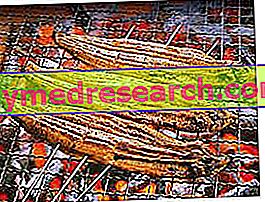Speaking of how to choose, prepare and cook the eel you could write an entire book (to be honest, someone has already done it).

Choice of Eel
The variables to be taken into consideration are:
- Origin: sea, brackish water from the valley, fresh water from the lake or river, fresh water from fish farming. The best are ALWAYS those of the sea; followed by those of lake or stony river, to then come to those of breeding in the valley (taking care NOT to buy them in the summer period - in which we often witness the death of molluscs of which the eels feed on acquiring a bad taste - and possibly inquiring about the valley of origin); I do not recommend intensive freshwater breeding. The eel feeds mainly on shrimp, crabs and small fish, as well as that of the river; this has a positive impact on both the taste and the nutritional composition of the eel. On the contrary, those bred in intensive fish farming are fed with animal meal pellets .
- Conservation status: the eel should be purchased alive to be cleaned or cleaned seductively by the fishmonger. An unclean dead eel remains very little; the meat does not spoil quickly but the fermentation of the digestive mixture takes place and, in the cleaning process, if unfortunately it is severed or damaged, it would release an unpleasant odor that could take root (albeit slightly) in the meat. Better a clean eel immediately and frozen than an ever frozen eel but 2-3 days dead and chilled.
- Size of the eel: if you prefer, the most ductile eel is the medium-sized eel, about 500-700g. A small eel, in addition to providing too much deviation from the edible part, absolutely does not deserve to be taken. On the contrary, a large eel (1-2kg), in addition to being more oily, needs a cooking skill worthy of an expert.
How to clean the eel
It is almost useless to write it, you should see it and try it!
Watch the video
X Watch the video on youtubeA great deal of dexterity is required to learn how to "scrape" the eel. The instruments are quite unique and have little to do with the classic cutting board and knife. These are: wood board (nicely called "sciapadora"), 2 awls (with which the eel is fixed - one on the mouth or on the head and the other on the tail) and a cutter (to cut the eel carefully necessary that the blade is as sharp as a scalpel). The eel opens from the BACK and NOT from the BELLY. Summarizing the process:
- Clean the eel from the external mucus (with absorbent paper or a cloth)
- On the axis, point the eel's tail up with one of the punches; NB . The fish's back should face the dominant hand of the operator
- With the other awl, fix the eel's mouth / head taking care that the body is under tension
- With the cutter, cut the meat longitudinally close to the awl of the tail (top) without cutting the spine
- From there, perform a 4-5mm deep surgical incision (just below the skin) along the back, ending on the eel's skull
- Starting from the tail, on the line of the superficial cut just executed, engrave deeply by sliding the blade against the spine up to the head. NB . Arriving at the abdominal cavity, cutting the tiny thoracic cage thorns, be careful NOT to pierce the viscera; puncturing the gall bladder the meat would take on a greenish color
- Now, with the cutter, incise for 1-2mm the tiny spines that start from the spinal column starting up from the tail and crawling sideways the spine, both above and below it
- Also from the tail, pierce the cutter BEHIND the spine and scrape it back to the head; now, the spine should be attached to the flesh ONLY on the tail and on the head
- Eliminate the spine by cutting it close to the tail and head; to it, in the removal, a good part of the viscera should remain adherent; therefore discard also the remaining ones from the belly
- Finally, extract our "scarf" from the axis (so called for the typical flat shape).
WARNING! Some appreciate that the eel, although "scarred", keeps the spine attached to the flesh. This variant does not significantly compromise the cooking of FROZEN fish (in the larger specimens it extends it slightly) although, in the fresh one, it causes a "curling" of the animal on itself which sometimes makes the cooking operation on the grill quite difficult .
How to cook eel
It is almost useless to write it, you should see it and try it!
Watch the video
X Watch the video on youtubeThe eel can be packaged in an OPTIMAL manner: grilled (exclusively on the grill and, at the limit, with a gas grill ... absolutely NOT with an electric grill), stewed (or in any case in the sauce for the first courses) and fried. I will not go into this last method because it requires the use of young specimens that, as we have already said, do not deserve to be taken. For what concerns the stewed eel, I suggest to consult the Neapolitan recipe of the eel capitone even if, personally, I don't appreciate the taste (excessively fat) as it creates remarkable digestive difficulties. Grilling is recommended for fatty fish such as eel.
For grilling it is always good to remember to use a heat source with intensity suitable for the size (and therefore the thickness) of the fish; the larger the eel, the less intense the fire must be, prolonging the cooking even beyond 20-30 '. The adult eel has up to 1/3 of its own weight in fat, even if through the heat treatment it ends up losing a very high percentage. The kind readers do not delude themselves, the eel remains however a very caloric fish, but its digestibility and the nutritional content can be very different based on the manuality of the "grill". Wanting to be meticulous, the optimal wood embers for eels are made from vine wood or, in general, from untreated fruit trees.
Tradition has it that the eel being cooked is turned only twice ... but it is not always possible to do it (especially for beginners); what is more important, however, is the side on which the fish is started to cook, that is ALWAYS that of the skin. The eel will then be turned when the meat clears and begins to exude large amounts of water and fat, making sure to check that the side of the skin being cooked has acquired a very intense color but not "black-burned". Once turned, pay attention: the fat of the eel ignites easily and it is not uncommon for flare-ups to burn the flesh superficially. Proceed then with the cooking on the side of the meat until it acquires a more or less intense browning: the bigger the animal, the more the surface of the meat will be subjected to the Maillard reaction. Turn the fish one last time to finish cooking the meat and dry the skin; when a certain "rigidity" of the "scarf" is perceived (due to the dehydration of the eel, the drainage of the fat, the drying of the skin and the formation of a crispy crust on the meat) the cooking will be concluded. WARNING! If it is true that accurately grilled sea eel is an almost priceless delicacy, it is equally true that the same fish insufficiently cooked or burnt represents torture for the palate; an undercooked eel is easily recognizable for the turgid and rubbery consistency, as well as for the clearly visible layer of fat, the flesh placed under the skin. On the contrary, in cooked fish "by hand" the fat is totally dissolved (except for fish that exceed 1.0-1.5 kg in weight) and the fork sinks well into the meat which takes on a crunchy consistency on the surface and is soft to heart.



